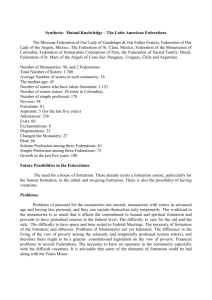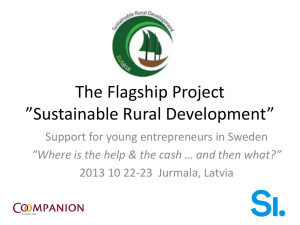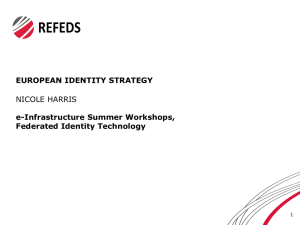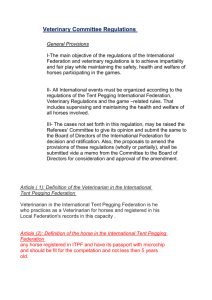Minor Variations
advertisement
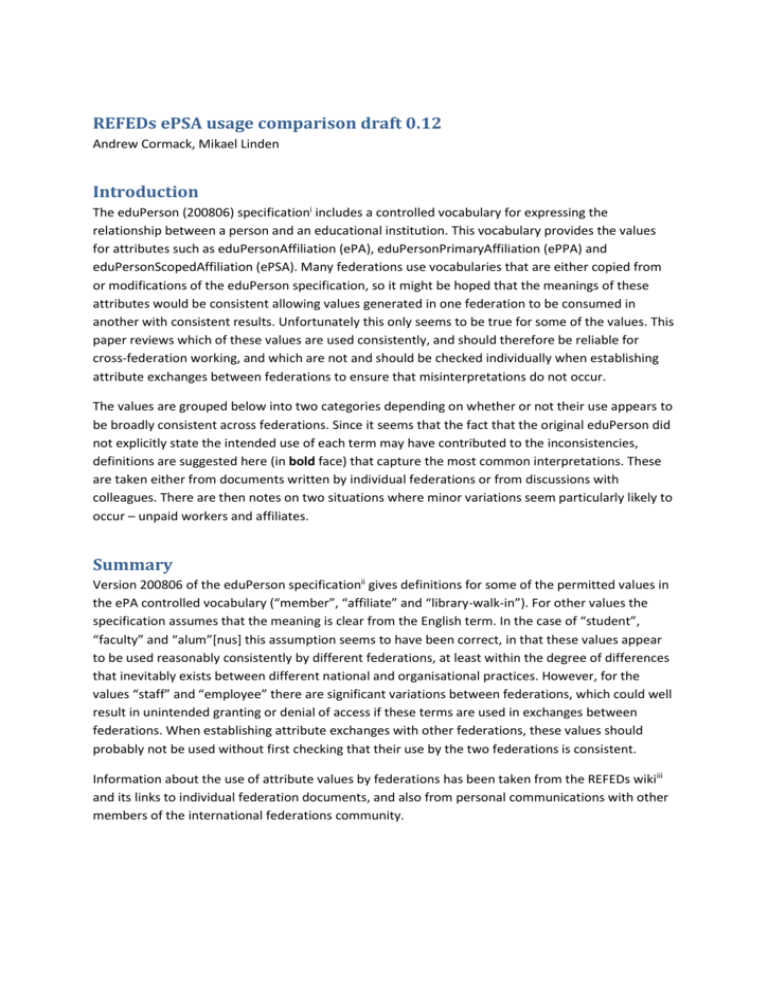
REFEDs ePSA usage comparison draft 0.12 Andrew Cormack, Mikael Linden Introduction The eduPerson (200806) specificationi includes a controlled vocabulary for expressing the relationship between a person and an educational institution. This vocabulary provides the values for attributes such as eduPersonAffiliation (ePA), eduPersonPrimaryAffiliation (ePPA) and eduPersonScopedAffiliation (ePSA). Many federations use vocabularies that are either copied from or modifications of the eduPerson specification, so it might be hoped that the meanings of these attributes would be consistent allowing values generated in one federation to be consumed in another with consistent results. Unfortunately this only seems to be true for some of the values. This paper reviews which of these values are used consistently, and should therefore be reliable for cross-federation working, and which are not and should be checked individually when establishing attribute exchanges between federations to ensure that misinterpretations do not occur. The values are grouped below into two categories depending on whether or not their use appears to be broadly consistent across federations. Since it seems that the fact that the original eduPerson did not explicitly state the intended use of each term may have contributed to the inconsistencies, definitions are suggested here (in bold face) that capture the most common interpretations. These are taken either from documents written by individual federations or from discussions with colleagues. There are then notes on two situations where minor variations seem particularly likely to occur – unpaid workers and affiliates. Summary Version 200806 of the eduPerson specificationii gives definitions for some of the permitted values in the ePA controlled vocabulary (“member”, “affiliate” and “library-walk-in”). For other values the specification assumes that the meaning is clear from the English term. In the case of “student”, “faculty” and “alum”[nus] this assumption seems to have been correct, in that these values appear to be used reasonably consistently by different federations, at least within the degree of differences that inevitably exists between different national and organisational practices. However, for the values “staff” and “employee” there are significant variations between federations, which could well result in unintended granting or denial of access if these terms are used in exchanges between federations. When establishing attribute exchanges with other federations, these values should probably not be used without first checking that their use by the two federations is consistent. Information about the use of attribute values by federations has been taken from the REFEDs wikiiii and its links to individual federation documents, and also from personal communications with other members of the international federations community. Generally Consistent Terms The values “member”, “faculty”, “student”, “alum”[nus] and “walk-in-user” appear to be used consistently across federations, at least to the extent that variations in national and organisational practice permit. For example there may be minor variations in the time at which an applicant for a place becomes “student”, or when they change to “alum”[nus]. Emeritus and retired staff may or may not be included within “member” or “faculty”, etc. These variations appear inevitable when dealing with educational organisations – a controlled vocabulary cannot create more consistency than exists in the world it describes – however they should not seriously affect the intentions of access agreements. Member Defined in the eduPerson specification as “intended to include faculty, staff, student, and other persons granted a basic set of privileges that go with membership in the university community (e.g., library privileges). It could be glossed as ‘member in good standing of the university community.’”iv The value appears to be used consistently in accordance with this definition, though it should be noted that different organisations may have different views on edge cases such as unpaid visiting lecturers (see below), retired and emeritus staff, etc. Faculty This value is not defined in the eduPerson specification, but appears to be used consistently by all federations to refer to workers whose primary role is teaching or research. Student This value is not defined in the eduPerson specification, but appears to be used consistently by all federations to refer to those who are studying at undergraduate or postgraduate level. Alum This value is not defined in the eduPerson specification, but appears to be used consistently by all federations to refer to those who are former students of the organisation (note however that there may be some variation – both between and within organisations – in whether individuals who did not complete their course are considered alumni). Library-walk-in Defined in the eduPerson specification as “intended to facilitate the handling of a fairly widely encountered agreement between an institution and licensed resource providers that e-resources may be made accessible to students, faculty, staff and library walk-ins. This term originally indicated people who were physically present in a library facility. In recent years the library walkin provision has been extended to cover other cases such as library users on the campus network, or those using on-campus workstations”.v This value has been added relatively recently to the controlled vocabulary and its definition in the standard should ensure that it is adopted with reasonable consistency. Inconsistent Terms The values “staff” and “employee” appear to have been less obvious in meaning than the drafters of the eduPerson specification had hoped. Different federations have drawn significantly different conclusions: in some federations “employee” is, literally, anyone with a contract of employment, whereas in others the value is not used. These values are therefore likely to cause misunderstandings when transferred from one federation to another – in the worst case a Finnish service provider who intended to make a resource available to anyone employed by a university might actually exclude all access from Swiss universities where the value is not used! Staff “Staff” is the term commonly used in North America for workers other than teachers and researchers (who are referred to as “faculty”). The intention of the eduPerson specification was therefore that every individual who worked for an educational organisation would be either “faculty” or “staff”. Unfortunately this usage does not appear to cross the Atlantic: in the UK “staff” is a general term for those working for an organisation, including both teachers and researchers. This latter usage was therefore adopted by the UK Access Management Federation,vi making it inconsistent with most other European and North American federations. Since most federations do use this value consistently, it is probably best to define it, as intended, as workers other than teachers or researchers. Employee “Employee” appears to have caused more widespread confusion than “staff”. Four different interpretations have been identified among the REFEDs members: Anyone who has an employment contract with the organisation: apparently the eduPerson intention and used by at least one European federation; Anyone who works for the organisation, including all teachers, researchers and support workers. As described below, this may include unpaid workers, who would not be included in the literal interpretation above; Any worker who is not “faculty”, for example those in support roles: the UK federation uses “employee” for these, where most other federations use “staff”; Not used, either silentlyvii or by declaration.viii There is therefore a significant risk that any given pair of federations will use this value differently. The best solution appears to be either omit the value or use the literal interpretation of anyone who is employed by the organisation while remaining aware that some federations and organisations may include unpaid and uncontracted workers in this category. Since some organisations may in any case add these workers to their payroll database, with a zero salary, in order to issue them with library cards and for other necessary administrative functions, this variation seems inevitable. Minor Variations Two other situations have been noted during discussions where federations (and indeed the organisations that are their members) may not behave in the same way. Neither of these is likely to be significant for access management decisions, though they provide a warning against making too precise assumptions about the meaning and relationship of attribute values. Unpaid workers Many universities have people working for them who do not have employment contracts with the organisation. Such people may perform both academic and support roles – for example courses of lectures may be delivered by employees of other organisations, or support work may be done as part of national or community service. The classification of such individuals has always been a matter of discussion in universities and this may well result in them being assigned to access management categories in ways that vary between organisations. For example one federation expects that unpaid workers would be assigned to “staff” or “faculty” as appropriate to their role, would not be marked as “employee”, but would be marked as “member”. This, incidentally, breaks the common assumption that all members are either employees or students. Another federation has concluded that visiting lecturers should be “faculty” but not “member”. Affiliate Although the value “affiliate” is defined in the eduPerson specification as “people with whom the university has dealings, but to whom no general set of ‘community membership’ privileges are extended”,ix the category has also been defined informally as “everyone who isn’t a member”. It is not clear whether these two definitions are consistent, or indeed whether either of them is what is actually being implemented. In particular most federation specifications appear to treat “affiliate” as a class on the same level as “alum”[nus], whereas on either of the above definitions it should actually be a superset of “alum”[nus]. Unless practice is clarified and found to be consistent, this value is another that is probably best treated with caution in any interaction between different federations. Since there appears to be less likelihood of significant access control decisions being based on the presence or absence of “affiliate” status, this uncertainty seems to represent less of a risk than the “employee”/”staff” inconsistencies described above. Conclusions While a statement of the intended meaning of each value might not have prevented significant misunderstandings, it might make them less likely in future. This paper therefore suggests possible definitions (in bold face) for those values that do not have them in the current eduPerson specification. Further discussion of these is encouraged, though complete precision is unlikely to be possible as the real-world concepts of “student”, “worker”, etc. themselves vary between and within education systems. It should also be noted that the biggest difference of interpretation that has been found is between two federations that share the same native language: this is not just a problem of linguistic translation! This paper has highlighted some differences between the use of controlled values between federations, but it may well be that other differences exist. As inter-federation develops it is likely that more of these will be discovered: it would be helpful if those who discover such differences could document them so that others can be made aware of them. Finally, although the discovery that two attribute values are used in significantly differing ways might appear to be a problem for inter-federation work, this may well be less serious than it appears. The existing controlled vocabulary appears to have developed from an examination of university structures, rather than the needs of specific use cases. In fact for very many licensed resources (and in particular, anything to which a site licence applies) all that is needed is the affiliation “member” plus, perhaps, a persistent anonymous identifier to allow the resource to store configurations, searches and other personalisation information from one user session to the next. The lack of a reliable way to distinguish between workers and students might appear a problem, but in fact most organisations have sufficient individuals who have both roles that a licence that attempted to exclude one group while permitting the other would in any case suffer from significant leaks. Many of the services that require authorisation at a more detailed level than a site licence involve specific groups of users defined either by enumeration (e.g. members of a project or discussion group) or by some characteristic that is specific to, and only meaningful within, a single organisation (e.g. teachers of first year computer science students). Thus, for these applications too, the problem values of the affiliation controlled vocabulary are unlikely to have a significant effect, since their intention is at too high a level of the organisational structure. i http://middleware.internet2.edu/eduperson/docs/internet2-mace-dir-eduperson-200806.html ii http://middleware.internet2.edu/eduperson/docs/internet2-mace-dir-eduperson-200806.html iii https://refeds.terena.org/index.php/Federations iv http://middleware.internet2.edu/eduperson/docs/internet2-mace-dir-eduperson200806.html#eduPersonAffiliation v http://middleware.internet2.edu/eduperson/docs/internet2-mace-dir-eduperson200806.html#eduPersonAffiliation vi http://www.ukfederation.org.uk/library/uploads/Documents/technical-recommendations-forparticipants.pdf vii http://www.switch.ch/aai/support/documents/attributes.html viii https://refeds.terena.org/index.php/FederationRENATER ix http://middleware.internet2.edu/eduperson/docs/internet2-mace-dir-eduperson200806.html#eduPersonAffiliation
